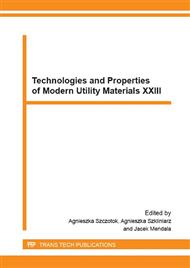[1]
K. Stransky, F. Kavička, J. Bažan, D. Horakova, J. Dobrowska, P. Lev, Zmĕny chemickeho složeni kapilar (kanalku) oxidickych keramickych filtru při filtrai oceli – jejich přičiny a dusledky Hutnicke listy LXII (3) (2009) 11-17.
Google Scholar
[2]
K. Janiszewski, Refining of liquid steel in a tundish using the method of filtration during its casting in the CC machine, Arch. Metall. Mater. 58 (2013) 509-517.
DOI: 10.2478/amm-2013-0029
Google Scholar
[3]
K. Stransky, J. Bažan, Z. Bužek, D. Horakova, Filtrace tavenin železa v prumyslove praxi, Vysoka škola baňska – Technicka Univerzita Ostrava (2008).
Google Scholar
[4]
K. Janiszewski, The slenderness ratio of the filter used in the process of liquid steel filtration as the additional parameter of the filter form, Steel Res. Int. 84 (3) (2013) 288-296.
DOI: 10.1002/srin.201200077
Google Scholar
[5]
K. Janiszewski, B. Panic, Industrial investigations of the liquid steel filtration, Metalurgija 53 (3) (2014) 339-342.
Google Scholar
[6]
K. Janiszewski, Z. Kudliński, The influence of non metallic inclusions physical state on effectiveness of the steel filtration process, Steel Res. Int. 77 (3) (2006) 169-176.
DOI: 10.1002/srin.200606371
Google Scholar
[7]
M. Tkadleckova, P. Machovcak, K. Gryc, Numerical modeling of macrosegregation in heavy steel ingot, Arch. Metall. Mater. 58 (1) (2013) 171-177.
Google Scholar
[8]
K. Janiszewski, Refining of liquid steel multi-hole ceramic filters in protective atmosphere, The work of the Institute of Ferrous Metallurgy T61 (5) (2009) 78-82.
Google Scholar
[9]
K. Janiszewski, B. Gajdzik, A. Wyciślik, The influence of slenderness ratios of multi-hole ceramic filters from SF - 1. 67 to SF - 8. 36 of filter surface on efficiency of liquid steel refining from non-metallic phase, Solid State Phenom. 212 (2014).
DOI: 10.4028/www.scientific.net/ssp.212.205
Google Scholar


